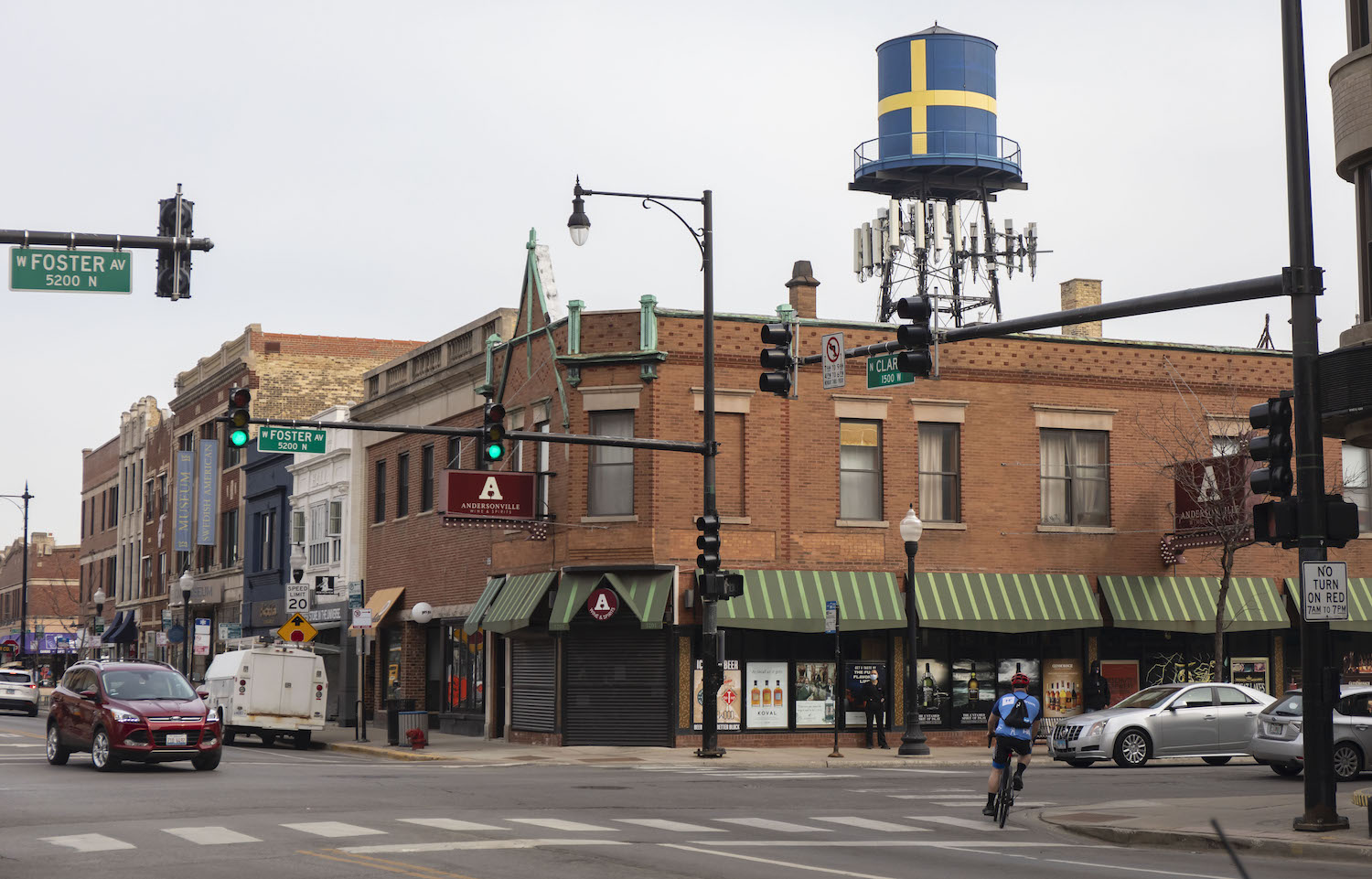Andersonville is the perfect name for the shopping strip on Clark Street between Foster and Bryn Mawr. But only if it’s named after director Wes Anderson, not the most common Swedish surname. The Swedes left Andersonville generations ago, moving to the suburbs after World War II. They’ve been replaced by fans of Moonrise Kingdom and The Royal Tenenbaums.
I recently spent a weekend browsing in Andersonville. Everywhere I went, I saw Wes Anderson’s aesthetic: the fetishization of obsolescent, analog technology; the preference for the artisanal over the mass produced; the nostalgia for childhood, even a childhood that predates one’s own. It’s so prevalent that the handbells imprinted in the sidewalks, which were rung to signal it was time for the orderly Swedes to sweep their doorways, should be replaced with bas-reliefs of a bearded Bill Murray wearing a knit cap. The Swedish flag on the water tank should be painted over with the Rushmore poster. (They do share a similar color scheme.)
The very first place I went was Rattleback Records, which, of course, sells almost nothing but vinyl. Moonrise Kingdom begins with children playing an LP of Leonard Bernstein’s The Young Person’s Guide to the Orchestra on a portable record player. When Suzy Bishop runs away from home, that record player is one of the few possessions she takes with her, along with a Françoise Hardy single. Rattleback doesn’t stock Hardy (or Benjamin Britten) but it does sell many of Anderson’s favorite soundtrack artists: The Kinks, Nick Drake, Elliott Smith, David Bowie, the Velvet Underground and Nico.
Kopi: A Traveler’s Cafe, has been open since 1991, five years before Anderson directed his first movie, Bottle Rocket. Yet here you’ll find the same Occidental fascination with Eastern exoticism he displayed in The Darjeeling Limited. The clocks above the bookshelves display the times in Moscow, Goa, Yogyakarta, Rotorua, and Kyoto. The bookshelves themselves are stocked with Lonely Planet Guides to Goa, Mumbai and Nepal. In the bathroom is an old world map, labeled with such abandoned colonial names as Belgian Congo and the Anglo-Egyptian Sudan. A very Andersonian touch. However, there’s a trigger warning underneath: “Dear Kopi Patrons, The maps on this wall are reproductions. Please don’t be insulted, upset or angry about the inaccuracies that you may find.”
Wes Anderson loves old technology: trains, rotary phones and bathyspheres. So does Andersonville Antiques, where there’s a selection of film cameras, analog clocks and typewriters. (Very Grand Budapest Hotel. Wes Anderson fans will probably also love the mechanical cash register at Simon’s Tavern.) He loves books. Suzy Bishop was always reading. Eli Cash in The Royal Tenenbaums was an author. Andersonville has books — used, at Uncharted, and new, at Women & Children First. And he loves the handmade, such as the belts and purses you’ll find at Chicatolia Artisan Collective. (All the characters in Anderson’s animated Isle of Dogs were handmade.)
At the end of The Life Aquatic with Steve Zissou, Bill Murray places a hand on Cate Blanchett’s pregnant belly.
“In twelve years he’ll be eleven and a half,” she says.
“That was my favorite age,” Murray says wistfully.
At Strange Cargo, you can be eleven and a half again. You can buy an ant farm. A Chinese finger trap. A Batman action figure. A Peanuts lunchbox. A pack of Growing Pains trading cards. (Also a Bill Murray t-shirt, although it’s Stripes Bill Murray.) The store offers a return to childhood, just like a Wes Anderson movie.
Wes Anderson, though, offers his viewers a return to a particular kind of childhood. His children are precocious, misunderstood, different. In Rushmore, Max Fischer puts on a high school production of Serpico. Margot Tenenbaum wins a $50,000 grant for a play she wrote in ninth grade. Moonrise Kingdom’s Sam Shakusky is the least popular kid in the Khaki Scouts, but he can survive in the wilderness like a mountain man. If you were that kind of kid, Wes Anderson gets you. If you’re that kind of grownup, Andersonville gets you. You don’t want to shop at Crate & Barrel. You want a piece of furniture as offbeat, unusual, and one-of-a-kind as you are, from GL Home Decor. You don’t want a Pepsi. You want grapefruit/juniper sparkling water, from Ándale Market. You don’t want a Cubs t-shirt. You want a t-shirt of Jane Byrne smoking a cigarette with Bozo, from Andersonville Galleria.
“When you arrive in Andersonville, you feel you have arrived someplace special,” declares the Andersonville website. “While our roots are Swedish, we are also recognized as the ‘shop local capital of Chicago,’ supporting the largest network of local and independent businesses in the area.”
Wes Anderson’s films define indie style. Andersonville is the quintessential indie neighborhood. No wonder they share the same name.
Related Content



